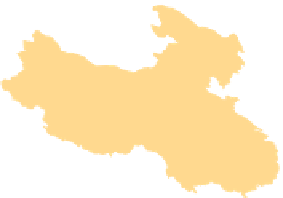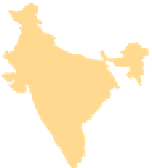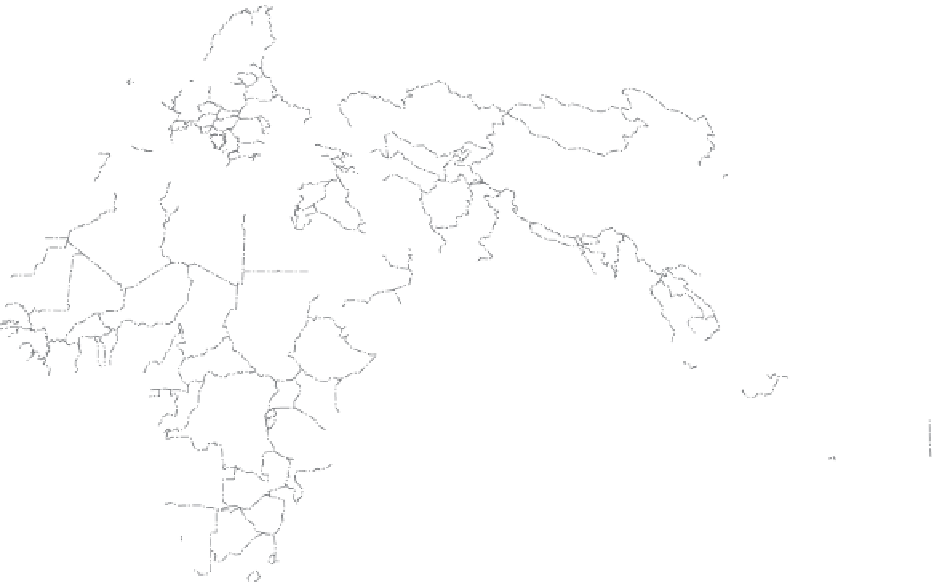Geography Reference
In-Depth Information
GREENLAND
8
Arctic Circle
7
FINLAND
NORWAY
ICELAND
10
RUSSIA
9
ESTONIA
LITHUANIA
60°
60°
SWEDEN
16
14
14
11
LATVIA
BELARUS
UKRAINE
DENMARK
10
UNITED KINGDOM
10
NETH.
GER.
9
POLAND
IRELAND
6
9
10
11
10
14
CZ. REP.
SLVK.
ROM.
BULG.
MACE.
MOLDOVA
ATLANTIC
BELG.
11
11
16
AUST.
10
11
12
KAZAKHSTAN
HUNG.
11
SWITZ.
9
13
9
MONGOLIA
SLOV.
BOS.
FRANCE
12
14
6
CRO.
OCEAN
9
14
9
GEORGIA
ARMENIA
10
UZBEKISTAN
TURKMENISTAN
KYRGYZSTAN
TAJIKISTAN
7
ITALY
10
SERB.
MONT.
9
N.
KOREA
SPAIN
PORTUGAL
8
9
40°
5
40°
9
11
GREECE
TURKEY
CYPRUS
7
JAPAN
9
9
6
11
KOS.
6
ALB.
CHINA
6
10
7
AZERBAIJAN
S.
KOREA
TUNISIA
SYRIA
7
6
7
7
4
MOROCCO
6
IRAQ
IRAN
LEBANON
AFGHANISTAN
6
6
5
3
5
17
PACIFIC
BHUTAN
ISRAEL
JORDAN
2
NEPAL
PAKISTAN
ALGERIA
KUWAIT
7
LIBYA
7
7
3
WESTERN
SAHARA
5
BAHRAIN
3
EGYPT
2
9
5
QATAR
2
BANGLADESH
7
TAIWAN
Tropic of Cancer
U.A.E.
6
SAUDI
ARABIA
MYANMAR
(BURMA)
8
INDIA
20°
OMAN
LAOS
MAURITANIA
3
4
8
8
9
MALI
NIGER
ERITREA
7
14
5
THAILAND
CAMBODIA
VIETNAM
14
OCEAN
SEN
E
GAL
GAMBIA
GUINEA-BISSAU GUINEA
SIERRA LEONE
LIBERIA
CHAD
SUDAN
8
YEMEN
PHILIPPINES
6
7
9
16
11
BURKINA
FASO
8
15
13
DJIBOUTI
8
8
9
11
IVORY
COAST
NIGERIA
CAMEROON
SRI LANKA
12
SOUTH
SUDAN
CENTRAL
AFRICAN REP.
ETHIOPIA
9
16
6
BRUNEI
11
11
10
15
11
SOMALIA
3
IN D I A N
TOGO
BENIN
12
15
MALAYSIA
UGANDA
GHANA
8
5
12
KENYA
Equator
CONGO
SINGAPORE
0°
GABON
RWANDA
9
EQUATORIAL
GUINEA
13
12
5
10
PAPUA
NEW
GUINEA
THE
CONGO
10
BURUNDI
OCEAN
9
SOLOMON
ISLANDS
INDONESIA
11
TANZANIA
6
7
12
4
COMOROS
EAST TIMOR
6
7
ATLANTIC
ANGOLA
MALAWI
23
ZAMBIA
FIJI
13
VANUATU
13
6
7
MOCAMBIQUE
¸
MADAGASCAR
ZIMBABWE
BOTSWANA
20°
20°
NAMIBIA
8
20°
20°
20°
14
13
MAURITIUS
13
NEW
CALEDONIA
Tropic of Capricorn
7
11
AUSTRALIA
5
7
15
OCEAN
SWAZILAND
15
SOUTH
AFRICA
LESOTHO
17
NEW
ZEALAND
7
40°
40°
40°
0°
20°
40°
60°
100°
120°
140°
160°
60°
60°
60°
60°
SOUTHERN
OCEAN
Antarctic Circle
Future Population Growth
It may be unwise to assume that the demographic cycles of
all countries will follow the sequence that occurred in
industrializing Europe or to believe that the still-signifi cant
population growth currently taking place in Bangladesh,
Mexico, and numerous other countries will simply sub-
side. Nonetheless, many agencies monitoring global pop-
ulation suggest that the populations of most (if not all)
countries will stop growing at some time during the
twenty-fi rst century, reaching a so-called
stationary pop-
ulation level
(SPL). This would mean that the world's
population would stabilize and that the major problems to
be faced would involve the aged rather than the young.
Such predictions require frequent revision, how-
ever, and anticipated dates for population stabilization
are often moved back. Only a few years ago, the United
Nations predicted world population would stabilize at















































































































































































































































































































































































































































































































































































































































































